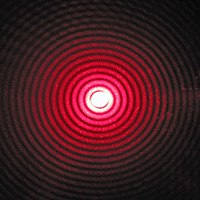
Photo from wikipedia
Abstract We analyzed the parameter effects of an optical knife-edge sensor (OKES) and the measurement uncertainty to achieve high linearity, long range, and high accuracy for nanopositioning stage applications. The… Click to show full abstract
Abstract We analyzed the parameter effects of an optical knife-edge sensor (OKES) and the measurement uncertainty to achieve high linearity, long range, and high accuracy for nanopositioning stage applications. The OKES utilizes interference fringes produced from diffraction across the knife-edge. The total field at the detector was calculated from superposition of the incident field and the diffracted field at the knife-edge, and the edge diffraction effects on the sensor design parameters (distance between the knife-edge and detector, wavelength and beam diameter) were investigated by using a design of experiment (DOE), 3-Level L 9 matrix from the Taguchi Method. Multi-factor experiments were designed to determine the relationship between factors affecting the interferogram and the sensor linearity. It was found that a shorter knife edge-detector distance, shorter wavelength, and larger beam diameter show high signal-to-noise ratio for sensing linearity. The OKES was modeled by using the electromagnetic wave propagation principle, and it was experimentally verified by controlling the positioning of an XY nanopositioning stage by the OKES. The sensor noise level showed X 20.1 nm and Y 19.4 nm, and the fundamental sensing limits of the OKES were estimated to be X 0.19 nm/ Hz and Y 0.23 nm/ Hz for a ±1.0 mm working range. These results indicate that the OKES can be a good alternative to other precision metrology tools because of its large working range, positioning accuracy, resolution, linearity, and bandwidth, as well as its compact size and low cost.
Journal Title: Measurement
Year Published: 2017
Link to full text (if available)
Share on Social Media: Sign Up to like & get
recommendations!